Viktor Moskvoretskii
Will It Still Be True Tomorrow? Multilingual Evergreen Question Classification to Improve Trustworthy QA
May 27, 2025Abstract:Large Language Models (LLMs) often hallucinate in question answering (QA) tasks. A key yet underexplored factor contributing to this is the temporality of questions -- whether they are evergreen (answers remain stable over time) or mutable (answers change). In this work, we introduce EverGreenQA, the first multilingual QA dataset with evergreen labels, supporting both evaluation and training. Using EverGreenQA, we benchmark 12 modern LLMs to assess whether they encode question temporality explicitly (via verbalized judgments) or implicitly (via uncertainty signals). We also train EG-E5, a lightweight multilingual classifier that achieves SoTA performance on this task. Finally, we demonstrate the practical utility of evergreen classification across three applications: improving self-knowledge estimation, filtering QA datasets, and explaining GPT-4o retrieval behavior.
LLM-Independent Adaptive RAG: Let the Question Speak for Itself
May 07, 2025Abstract:Large Language Models~(LLMs) are prone to hallucinations, and Retrieval-Augmented Generation (RAG) helps mitigate this, but at a high computational cost while risking misinformation. Adaptive retrieval aims to retrieve only when necessary, but existing approaches rely on LLM-based uncertainty estimation, which remain inefficient and impractical. In this study, we introduce lightweight LLM-independent adaptive retrieval methods based on external information. We investigated 27 features, organized into 7 groups, and their hybrid combinations. We evaluated these methods on 6 QA datasets, assessing the QA performance and efficiency. The results show that our approach matches the performance of complex LLM-based methods while achieving significant efficiency gains, demonstrating the potential of external information for adaptive retrieval.
Do I look like a `cat.n.01` to you? A Taxonomy Image Generation Benchmark
Mar 13, 2025Abstract:This paper explores the feasibility of using text-to-image models in a zero-shot setup to generate images for taxonomy concepts. While text-based methods for taxonomy enrichment are well-established, the potential of the visual dimension remains unexplored. To address this, we propose a comprehensive benchmark for Taxonomy Image Generation that assesses models' abilities to understand taxonomy concepts and generate relevant, high-quality images. The benchmark includes common-sense and randomly sampled WordNet concepts, alongside the LLM generated predictions. The 12 models are evaluated using 9 novel taxonomy-related text-to-image metrics and human feedback. Moreover, we pioneer the use of pairwise evaluation with GPT-4 feedback for image generation. Experimental results show that the ranking of models differs significantly from standard T2I tasks. Playground-v2 and FLUX consistently outperform across metrics and subsets and the retrieval-based approach performs poorly. These findings highlight the potential for automating the curation of structured data resources.
Self-Taught Self-Correction for Small Language Models
Mar 11, 2025Abstract:Although large language models (LLMs) have achieved remarkable performance across various tasks, they remain prone to errors. A key challenge is enabling them to self-correct. While prior research has relied on external tools or large proprietary models, this work explores self-correction in small language models (SLMs) through iterative fine-tuning using solely self-generated data. We introduce the Self-Taught Self-Correction (STaSC) algorithm, which incorporates multiple algorithmic design choices. Experimental results on a question-answering task demonstrate that STaSC effectively learns self-correction, leading to significant performance improvements. Our analysis further provides insights into the mechanisms of self-correction and the impact of different design choices on learning dynamics and overall performance. To support future research, we release our user-friendly codebase and lightweight models.
Challenges of Multi-Modal Coreset Selection for Depth Prediction
Feb 20, 2025Abstract:Coreset selection methods are effective in accelerating training and reducing memory requirements but remain largely unexplored in applied multimodal settings. We adapt a state-of-the-art (SoTA) coreset selection technique for multimodal data, focusing on the depth prediction task. Our experiments with embedding aggregation and dimensionality reduction approaches reveal the challenges of extending unimodal algorithms to multimodal scenarios, highlighting the need for specialized methods to better capture inter-modal relationships.
Argument-Based Comparative Question Answering Evaluation Benchmark
Feb 20, 2025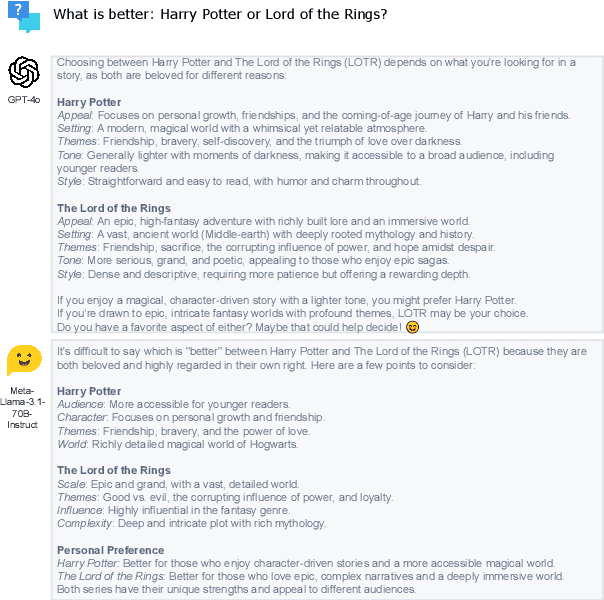
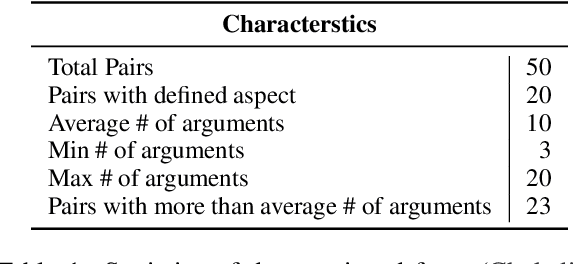
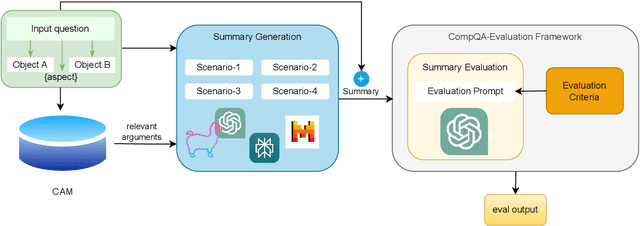

Abstract:In this paper, we aim to solve the problems standing in the way of automatic comparative question answering. To this end, we propose an evaluation framework to assess the quality of comparative question answering summaries. We formulate 15 criteria for assessing comparative answers created using manual annotation and annotation from 6 large language models and two comparative question asnwering datasets. We perform our tests using several LLMs and manual annotation under different settings and demonstrate the constituency of both evaluations. Our results demonstrate that the Llama-3 70B Instruct model demonstrates the best results for summary evaluation, while GPT-4 is the best for answering comparative questions. All used data, code, and evaluation results are publicly available\footnote{\url{https://anonymous.4open.science/r/cqa-evaluation-benchmark-4561/README.md}}.
Investigating the Impact of Quantization Methods on the Safety and Reliability of Large Language Models
Feb 18, 2025



Abstract:Large Language Models (LLMs) have emerged as powerful tools for addressing modern challenges and enabling practical applications. However, their computational expense remains a significant barrier to widespread adoption. Quantization has emerged as a promising technique to democratize access and enable low resource device deployment. Despite these advancements, the safety and trustworthiness of quantized models remain underexplored, as prior studies often overlook contemporary architectures and rely on overly simplistic benchmarks and evaluations. To address this gap, we introduce OpenSafetyMini, a novel open-ended safety dataset designed to better distinguish between models. We evaluate 4 state-of-the-art quantization techniques across LLaMA and Mistral models using 4 benchmarks, including human evaluations. Our findings reveal that the optimal quantization method varies for 4-bit precision, while vector quantization techniques deliver the best safety and trustworthiness performance at 2-bit precision, providing foundation for future research.
EBES: Easy Benchmarking for Event Sequences
Oct 04, 2024



Abstract:Event sequences, characterized by irregular sampling intervals and a mix of categorical and numerical features, are common data structures in various real-world domains such as healthcare, finance, and user interaction logs. Despite advances in temporal data modeling techniques, there is no standardized benchmarks for evaluating their performance on event sequences. This complicates result comparison across different papers due to varying evaluation protocols, potentially misleading progress in this field. We introduce EBES, a comprehensive benchmarking tool with standardized evaluation scenarios and protocols, focusing on regression and classification problems with sequence-level targets. Our library simplifies benchmarking, dataset addition, and method integration through a unified interface. It includes a novel synthetic dataset and provides preprocessed real-world datasets, including the largest publicly available banking dataset. Our results provide an in-depth analysis of datasets, identifying some as unsuitable for model comparison. We investigate the importance of modeling temporal and sequential components, as well as the robustness and scaling properties of the models. These findings highlight potential directions for future research. Our benchmark aim is to facilitate reproducible research, expediting progress and increasing real-world impacts.
GIFT-SW: Gaussian noise Injected Fine-Tuning of Salient Weights for LLMs
Aug 27, 2024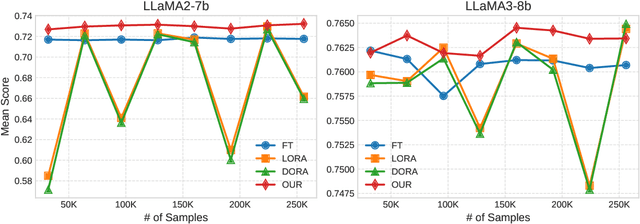

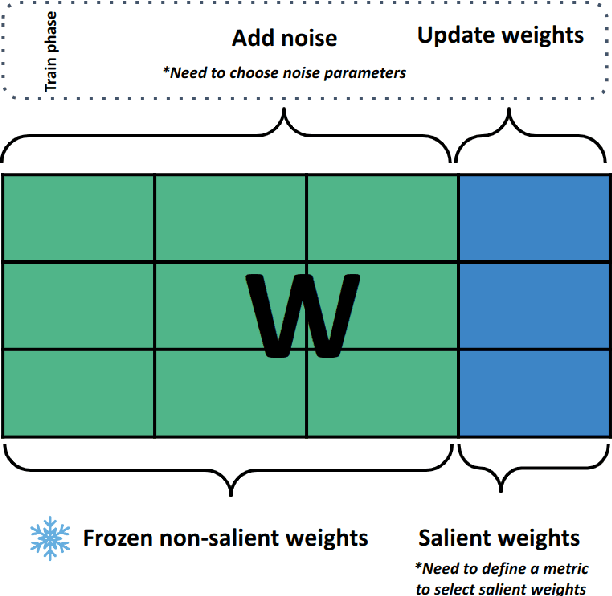
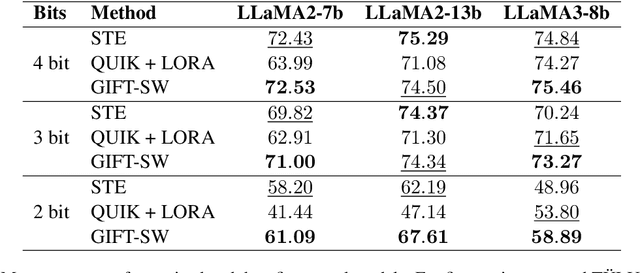
Abstract:Parameter Efficient Fine-Tuning (PEFT) methods have gained popularity and democratized the usage of Large Language Models (LLMs). Recent studies have shown that a small subset of weights significantly impacts performance. Based on this observation, we introduce a novel PEFT method, called Gaussian noise Injected Fine Tuning of Salient Weights (GIFT-SW). Our method updates only salient columns, while injecting Gaussian noise into non-salient ones. To identify these columns, we developeda generalized sensitivity metric that extends and unifies metrics from previous studies. Experiments with LLaMA models demonstrate that GIFT-SW outperforms full fine-tuning and modern PEFT methods under the same computational budget. Moreover, GIFT-SW offers practical advantages to recover performance of models subjected to mixed-precision quantization with keeping salient weights in full precision.
Low-Resource Machine Translation through the Lens of Personalized Federated Learning
Jun 18, 2024



Abstract:We present a new approach based on the Personalized Federated Learning algorithm MeritFed that can be applied to Natural Language Tasks with heterogeneous data. We evaluate it on the Low-Resource Machine Translation task, using the dataset from the Large-Scale Multilingual Machine Translation Shared Task (Small Track #2) and the subset of Sami languages from the multilingual benchmark for Finno-Ugric languages. In addition to its effectiveness, MeritFed is also highly interpretable, as it can be applied to track the impact of each language used for training. Our analysis reveals that target dataset size affects weight distribution across auxiliary languages, that unrelated languages do not interfere with the training, and auxiliary optimizer parameters have minimal impact. Our approach is easy to apply with a few lines of code, and we provide scripts for reproducing the experiments at https://github.com/VityaVitalich/MeritFed
 Add to Chrome
Add to Chrome Add to Firefox
Add to Firefox Add to Edge
Add to Edge